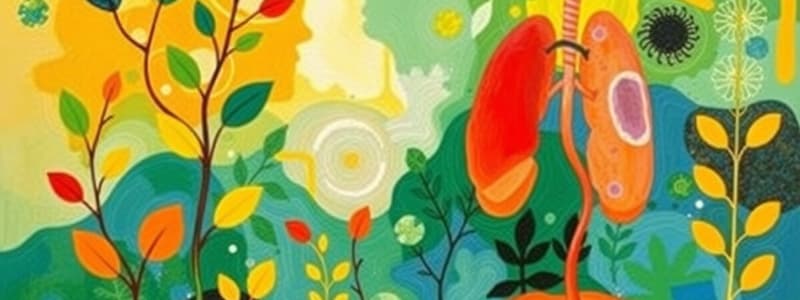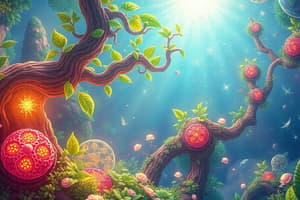Podcast
Questions and Answers
What does the term homeostasis refer to?
What does the term homeostasis refer to?
- The ability of an organism to adapt to its environment.
- The process of maintaining a balanced state in an organism's body. (correct)
- The production of energy by cells.
- The breakdown of food into smaller molecules.
Cellular respiration is the process of converting energy from food into a usable form.
Cellular respiration is the process of converting energy from food into a usable form.
True (A)
What are the two main types of cellular respiration?
What are the two main types of cellular respiration?
Aerobic and Anaerobic
Which of the following is NOT a waste product of cellular respiration?
Which of the following is NOT a waste product of cellular respiration?
The ______ is the powerhouse of the cell, where cellular respiration takes place.
The ______ is the powerhouse of the cell, where cellular respiration takes place.
Which of the following is NOT a characteristic of a good scientific experiment?
Which of the following is NOT a characteristic of a good scientific experiment?
Match the following organic compounds with their primary building blocks:
Match the following organic compounds with their primary building blocks:
Enzymes are biological catalysts that speed up chemical reactions without being consumed in the process.
Enzymes are biological catalysts that speed up chemical reactions without being consumed in the process.
What is the difference between diffusion and active transport?
What is the difference between diffusion and active transport?
Which of the following is a common mistake people make regarding photosynthesis and cellular respiration?
Which of the following is a common mistake people make regarding photosynthesis and cellular respiration?
What are the two main types of nutrition, and give an example of an organism that uses each type?
What are the two main types of nutrition, and give an example of an organism that uses each type?
Photosynthesis is a process that releases energy stored in the chemical bonds of sugar molecules.
Photosynthesis is a process that releases energy stored in the chemical bonds of sugar molecules.
Flashcards
Homeostasis
Homeostasis
A balanced state in an organism's body.
Feedback Mechanisms
Feedback Mechanisms
Cycles in which the product of one reaction causes another to start or stop.
Dynamic Equilibrium
Dynamic Equilibrium
A balanced state created by many small, opposing changes.
Metabolism
Metabolism
Signup and view all the flashcards
Nutrition
Nutrition
Signup and view all the flashcards
Cellular Respiration
Cellular Respiration
Signup and view all the flashcards
Synthesis
Synthesis
Signup and view all the flashcards
Transport
Transport
Signup and view all the flashcards
Regulation
Regulation
Signup and view all the flashcards
Excretion
Excretion
Signup and view all the flashcards
Reproduction
Reproduction
Signup and view all the flashcards
Water (H₂O)
Water (H₂O)
Signup and view all the flashcards
Carbon Dioxide (CO₂)
Carbon Dioxide (CO₂)
Signup and view all the flashcards
Oxygen (O₂)
Oxygen (O₂)
Signup and view all the flashcards
Nitrogen (N₂)
Nitrogen (N₂)
Signup and view all the flashcards
Hypothesis
Hypothesis
Signup and view all the flashcards
Independent Variable
Independent Variable
Signup and view all the flashcards
Dependent Variable
Dependent Variable
Signup and view all the flashcards
Control Group
Control Group
Signup and view all the flashcards
Experimental Group
Experimental Group
Signup and view all the flashcards
Constants
Constants
Signup and view all the flashcards
Cell Theory
Cell Theory
Signup and view all the flashcards
Cell
Cell
Signup and view all the flashcards
Unicellular
Unicellular
Signup and view all the flashcards
Multicellular
Multicellular
Signup and view all the flashcards
Study Notes
Photosynthesis and Cellular Respiration
- Photosynthesis is the process that converts light energy into chemical energy in the form of glucose.
- It takes place in chloroplasts, specifically in plants, algae, and some bacteria.
- Photosynthesis requires carbon dioxide, water, and sunlight.
- It produces oxygen as a byproduct.
- Cellular respiration is the process that breaks down glucose to release energy in the form of ATP (adenosine triphosphate).
- It occurs in the mitochondria in most organisms.
- Cellular respiration requires oxygen and produces carbon dioxide and water as byproducts.
Plant Adaptations
- Chloroplast: Chloroplasts are organelles containing chlorophyll, which is the pigment that absorbs sunlight for photosynthesis.
- Gas exchange: Stomata are pores on leaves that allow for gas exchange (taking in carbon dioxide and releasing oxygen). Guard cells control the opening and closing of stomata to regulate water loss.
- Transport: Xylem transports water, and phloem transports sugars throughout the plant.
Cellular Respiration
- Energy Production: Cellular respiration breaks down glucose to produce ATP, the main energy currency for cells.
- ATP: ATP is the primary energy source that cells use for various processes.
- Aerobic Respiration: Most organisms utilize aerobic respiration, which requires oxygen.
- Aerobic respiration takes place in the mitochondria.
- Waste products: Carbon dioxide and water are the waste products of aerobic respiration.
- Anaerobic Respiration (Fermentation): Some organisms can use anaerobic respiration without oxygen. This process produces less ATP than aerobic respiration.
- Lactic Acid Fermentation: During strenuous exercise, when muscles lack oxygen, lactic acid fermentation occurs, causing muscle fatigue.
- ATP (Adenosine triphosphate) is the molecule all cells use for energy.
Organic Compounds
- Carbohydrates: Sugars and starches are composed of simple sugars (e.g., glucose) and provide energy.
- Lipids: Fats and oils are made of fatty acids and have various functions, including storing energy, waterproofing, and forming cell membranes.
- Proteins: Amino acids combine to form proteins, which are crucial for cell structure and many bodily functions (enzymes, hormones, etc.).
- Nucleic Acids: DNA and RNA are composed of nucleotides and carry genetic information; important in protein synthesis.
Characteristics of a good experiment
- Repeatable: Can be performed multiple times to achieve consistent results.
- A large sample size: A large group of participants to ensure the accuracy of statistical inference.
- Long periods of time: Studies that last longer tend to provide more reliable conclusions.
- Independent variable test: Focusing on only changing one factor while keeping others constant to isolate causality.
- Peer reviewed: Having other scientists review and evaluate the experiment to confirm accuracy.
- Objective: The experiment and conclusions shouldn't reflect bias or personal opinions; must be driven by facts.
- Following ethical and legal standards: Experiments involve people or animals should meet ethical and legal requirements.
Plant Cells vs Animal Cells
- Cell walls are a defining feature of plant cells, not animal cells.
- Plant cells have large central vacuoles which store water and other substances.
- Plant cells contain chloroplasts and conduct photosynthesis, whereas animal cells do not.
Cell Transport
- Passive Transport: Movement of substances across a membrane without energy; diffusion and osmosis.
- Active Transport: Movement of substances across membranes from an area of lower concentration to an area of higher concentration using energy input (ATP).
Studying That Suits You
Use AI to generate personalized quizzes and flashcards to suit your learning preferences.




